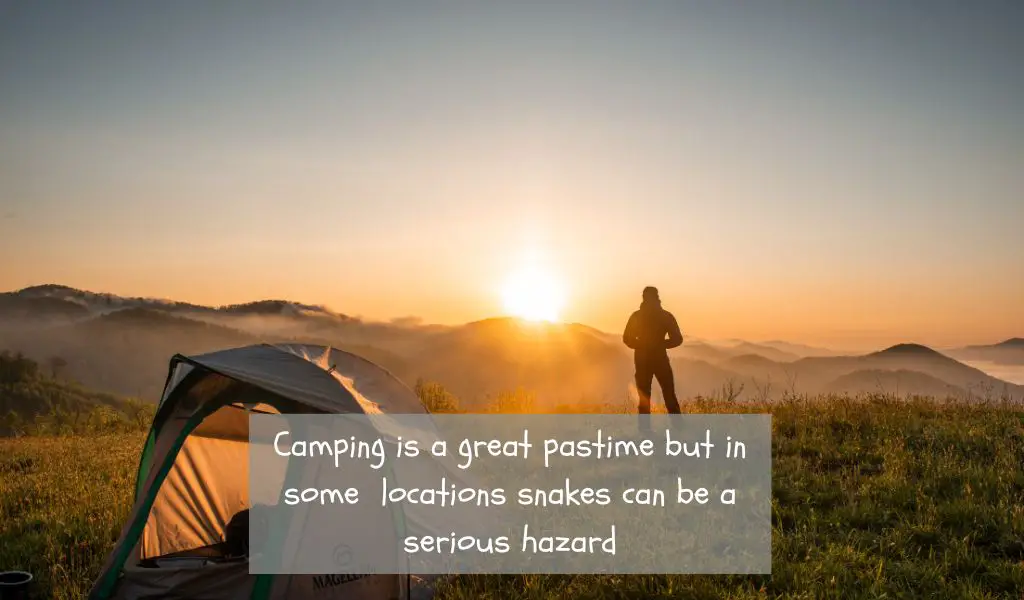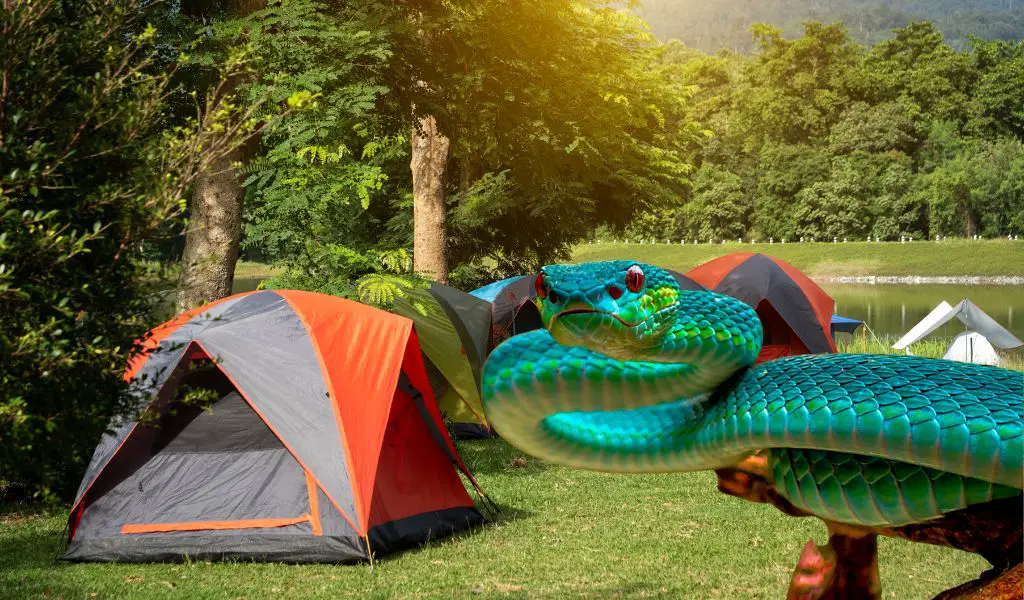Camping is a popular activity for those who love the great outdoors, but it can come with some risks.
One of these risks is encountering snakes while camping.
Snakes are cold-blooded reptiles that exist in many parts of the world and can be found near wooded areas, wetlands, and other outdoor environments.
Fortunately, there are ways to prepare for and avoid snake encounters while camping.
In this blog post we will discuss how to stay safe by looking at clothing and gear considerations as well as strategies for avoiding snake bites if an encounter should occur.
Table of Contents
Overview of why camping is a popular activity
Camping is a great way to escape the hustle and bustle of everyday life.
It can provide an opportunity to see nature in its raw form and experience activities such as fishing, hiking, canoeing, or star gazing.
Campers are able to get away from technology for a while, unplugging from the world around them and reconnecting with nature.
In a world of constant change and stress, camping can be an invaluable opportunity to relax and reset.
If you are camping in an area where snakes are known to live then it is important to know:
What species of snake is in the area
How to avoid snake encounters
How to deal with snake encounters
Where to get help ( and anti-venom ) if you, or a member of your camping party is bitten
Explanation of the risks associated with snakes while camping
While camping can provide a great escape from the world around us, it does come with some risks. One of these risks is encountering snakes.
They pose a threat to campers as some snake species are venomous and can cause serious injury or even death.
Clothing and gear considerations
When out camping, it is important to wear appropriate clothing to avoid any potential snake encounters.
Avoid bright colors and loud fabrics, as these can attract the attention of a nearby snake. Instead, opt for clothing in earth tones, such as browns and greens.
Wear long pants and boots or closed-toe shoes to protect yourself from any potential bites or stings.
Additionally, it may be beneficial to wear a hat with a wide brim to provide additional protection for your face and neck area.
It is also important to carry appropriate gear when camping. Bring a flashlight to keep your area illuminated at night and a first-aid kit in case of an emergency.

Strategies for avoiding snake bites
If you do happen to encounter a snake while camping, there are certain strategies that can help you avoid being bitten.
The most important thing to remember is to remain calm and keep your distance. Do not attempt to corner or touch the snake, as this could lead to an aggressive response.
Make a lot of noise and back away slowly and steadily. Make sure the path you are taking is clear, and never turn your back on the snake.
If the snake does not move away, find a large stick and use it to prod the snake in the direction you want it to go.
If you do get bitten by a snake, it is important to seek medical attention as soon as possible.
The dangers of camping and snakes
Camping is a popular past-time that everyone should enjoy at one point in their life.
But if you’re going to go camping, it’s important to know all of the potential risks associated with it – and that includes snake safety.
Snakes are usually found in areas where they can find food, such as around campsites.
They may be concealed in the undergrowth, and if startled, may strike or bite without warning.
There are many species of snakes found throughout the world and two main types of bites: venomous, which cause disease or death; and nonvenomous, which still can cause injury.
The best way to protect yourself from snakes while camping is to be aware of your surroundings at all times and stay vigilant while out in nature.
Snakes and camping
Avoid walking through tall grasses or other foliage where snakes may hide during the day.
Always wear protective clothing such as long pants, boots and gloves when walking through dense vegetation.
Avoid touching logs or rocks where a snake might reside during cool weather periods.
Do not attempt to catch or handle any snake even if it appears nonvenomous – it is illegal in most places anyway.
Instead leave them alone and call pest control services for assistance if needed.
Taking a few simple precautions can help you avoid dangerous encounters with snakes while camping:
Choose an open campsite away from wooded areas as much as possible
Never touch a snake without proper protection (ie long sleeves, gloves)
Make loud noises regularly or whistle while walking so snakes can hear you coming
Stay away from logs and large rocks where snakes may hide during cool weather periods
Check your feet before putting them back into shoes or onto sleeping bags after leaving them unattended.
Preparation and prevention
Being prepared and taking the necessary precautions can help to reduce the chances of running into snakes while camping.
Choose a campsite that is far away from wooded areas or wetland habitats and inspect your surroundings before setting up camp.
Stay on clearly defined trails when hiking, and make noise so that any nearby snakes will know to stay away.
If you plan to go camping in areas where venomous snakes are known to live, it might be a good idea to carry a snakebite kit with you, just in case.
Clothing and gear considerations
When out camping, it’s important to wear clothing and gear that will protect you from snake bites.
Wear sturdy boots with at least 6 inches of ankle support, and long pants or chaps to cover your skin.
Synthetic fabrics are best as they offer more protection against fangs than cotton does.
You should also carry a flashlight or headlamp to use at night and make sure that your tent is tucked away from wooded areas.
Finally, if you spot a snake, never approach it. Stay at least ten feet away and move in the opposite direction as quickly as possible to avoid provoking an attack.
Strategies for determining if an area is snake-free
If you’re camping in an area where snakes may be present, there are a few strategies you can use to determine if it is snake-free.
First, look for signs of snake activity such as tracks and droppings. Snakes also tend to leave behind sloughed skin when they shed.
Look for snake tracks in the sand or mud and check around rocks, logs and other debris where they may hide.
Also, make sure to inspect your campsite for any snakes that might be hiding before you set up camp.
Finally, listen closely for hissing sounds or rustling noises as this is a common sign of a snake’s presence.
By following these strategies, it will be easier to identify if an area is snake-free and therefore safe for camping.
In the event of an encounter
If you do find yourself in a situation where you encounter a snake, the best thing to do is stay calm and back away slowly.
Never try to grab or pick up a snake as this will increase your chances of being bitten.
Instead, move away from the area quickly and call for help if needed. If someone is bitten, seek medical attention immediately and try to take the snake with you for identification.
It is also important to be aware of your surroundings when in nature as snakes may be lurking nearby, so remain vigilant at all times.
By following these tips and taking preventive measures, you can avoid dangerous encounters with snakes while camping and enjoy a safe outdoor experience.
These are just a few steps you can take to ensure your safety and have an enjoyable time in nature.
Be sure to always check local regulations regarding snakes before heading out on your adventure as well.
Finally, educate yourself on snake behaviour and identification so that you know how to react if you encounter one while camping outdoors.
What to do if you are bitten by a snake
If you are bitten by a snake, the most important thing is to seek medical attention immediately.
Try to stay calm and still and move away from the area slowly. Do not attempt to capture or kill the snake as this could make the situation worse.
Take note of any distinctive features of the snake that may help with identification and try to take a picture of it with your phone, if possible.
Be sure to also keep track of the time of the bite and any symptoms you experience.
Once medical help has been sought, try to stay calm and still until emergency services arrive.
Do not apply cold or heat, cut the wound, or attempt to suck out the venom as these methods of treatment are not effective.
It may also be helpful to bring an identification guide with you when camping, so that you can quickly identify the snake if needed.
By following these steps in the event of a bite, you can take the necessary precautions and seek treatment quickly.
Taking preventive measures and staying informed on how to respond to a snakebite is essential for any outdoor enthusiast.
Final Words
There are a number of steps you can take to prevent snakes from ruining your camping experience.
From checking for snake activity to following safety protocols in the event of an encounter, it is important to be aware of your surroundings and take preventive measures.
By educating yourself on snake behaviour and being prepared with the right tools, knowledge, and supplies, you can enjoy a safe and snake-free camping experience.
Finally, always seek medical attention if you are bitten by a snake as this is the best way to ensure your safety.
With these simple tips and strategies in mind, you can protect yourself from any potential danger when out in nature.








